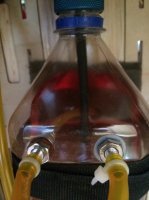Does anybody do a brass tube in their tank and if you do do you run out of fuel on really long downlines?
check this out:
pay attention to 19 or 20 seconds
i just came out of a 1/2 cuban 8 with a 45 degree downline.
this is a picture of the tank before and after i made the mods:
in the video, this is with the tank set up using the brass tube. In the video the motor wanting to shut down from the air bubbles, this was common to occur after about 5 minutes of flight, once the fuel level was about 1/2 of the 1.5 liter tank.
once i removed this brass tube and went with the Viton, the problem has been 100% solved. I also have discovered, Viton tube, and standard clunk, this can still happen. SO i went have changed my other planes to the felt clunk, and now, no more hiccups.
i am ashamed to mention this, but sometimes, a few times only, by the grace of God, i have landed the airplane, and the tank did not have a drop of fuel left!!!
The felt clunk really helps to keep the flow of fuel to the carb.

